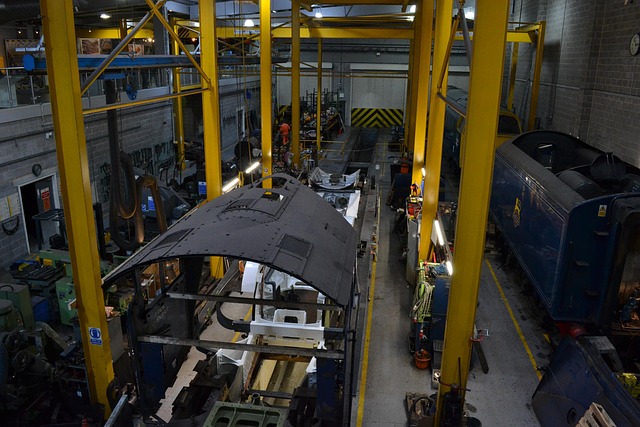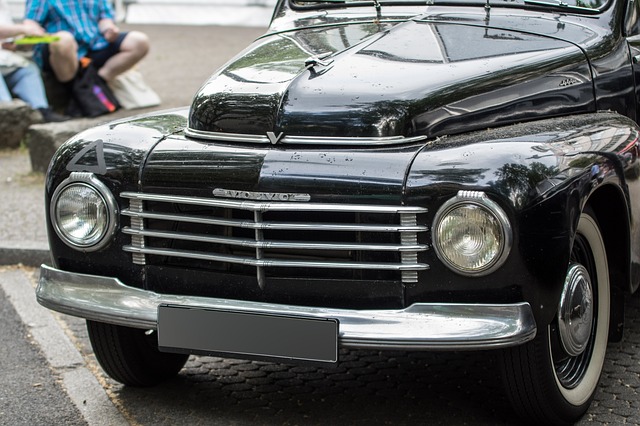Cooling System Collision Repair: Impact on Engine Performance Restoration
Cooling system collision repair is a critical step after any automotive accident, addressing hidden…….
In the realm of automotive engineering and safety, cooling system collision repair stands as a critical practice aimed at ensuring vehicle performance and passenger well-being post-collision. This intricate process involves the meticulous restoration and reinforcement of a car’s cooling systems—a vital component often overlooked in the immediate aftermath of an accident. The article that follows delves into the intricacies of this specialized field, exploring its historical evolution, global impact, technological innovations, economic implications, regulatory frameworks, and the challenges it faces. By examining these facets, we aim to illuminate the significance of cooling system collision repair as a vital link in the chain of vehicle safety and recovery.
Definition and Core Components:
Cooling system collision repair is a specialized automotive service that addresses the unique challenges posed by vehicle accidents on a car’s thermal management systems. This includes radiators, cooling fans, water pumps, heat exchangers, and associated hoses. The primary goal is to restore these components to their pre-accident condition, ensuring optimal cooling performance during operation.
The cooling system plays a critical role in regulating the engine’s temperature, preventing overheating, and facilitating efficient power generation. Damage to these systems during a collision can lead to significant thermal imbalances, impacting engine performance and potentially causing further structural damage. Therefore, skilled technicians employ specialized techniques and parts to reconstruct and enhance these vital components.
Historical Context:
The concept of cooling system repair has evolved alongside the automotive industry. Early vehicles relied on simple water-cooling systems, but as engines became more complex and powerful, so did the need for sophisticated thermal management. With the advent of modern cars, the focus shifted to efficient, reliable, and durable cooling systems, necessitating advanced repair techniques when accidents occur.
Cooling system collision repair is a global concern, with varying degrees of emphasis and standardization across countries. Here’s an overview:
North America: The United States and Canada have well-established guidelines for vehicle repair, including cooling systems. The National Institute for Automotive Service Excellence (ASE) offers specialized certification for technicians in cooling system repairs, ensuring a high level of expertise.
Europe: European countries have stringent safety standards, with organizations like Euro NCAP leading the way in crash testing and evaluation. Many European manufacturers design their vehicles with advanced cooling systems, emphasizing the importance of repair expertise.
Asia Pacific: The rapid growth of the automotive industry in regions like China and India has led to a corresponding rise in the demand for cooling system collision repair services. Local regulations are catching up, but the diversity of vehicle models presents unique challenges.
Rest of the World: Countries with emerging economies often face challenges in implementing standardized practices due to limited resources and varying legal frameworks. However, as global trade increases, there is a growing need to harmonize safety standards, including cooling system repair protocols.
The economic implications of cooling system collision repair are multifaceted:
| Factor | Impact |
|---|---|
| Market Size: The global automotive repair market, which includes cooling system repairs, is substantial and expected to grow. According to a 2021 report by Grand View Research, the global vehicle repair market size was valued at USD 584.9 billion in 2020 and is projected to expand at a CAGR of 6.7% from 2021 to 2028. | This growth indicates the increasing demand for specialized services like cooling system collision repair, presenting opportunities for automotive service providers. |
| Investment Patterns: Automotive manufacturers invest heavily in research and development (R&D) to create advanced cooling systems. For instance, electric vehicle (EV) makers are pioneering innovative thermal management solutions, driving technological advancements in cooling system repair. | These investments not only enhance vehicle performance but also contribute to the economic growth of the automotive industry as a whole. |
| Economic Impact on Regions: In regions with high vehicle ownership rates, like North America and Western Europe, cooling system collision repair services are in high demand. Local businesses specializing in this field can significantly contribute to regional economies. | Conversely, areas with limited access to specialized repair facilities may face higher costs for importing parts and expertise, impacting local automotive service industries. |
Technological innovations have revolutionized cooling system collision repair, offering improved efficiency, precision, and sustainability:
Computer-Aided Design (CAD) and 3D Printing: CAD software enables technicians to design and visualize complex cooling system components, ensuring precise repairs. Additionally, 3D printing allows for the rapid prototyping of custom parts, reducing lead times and costs.
Advanced Cooling Materials: New materials, such as lightweight alloys and advanced composites, are being developed for improved thermal conductivity and enhanced structural integrity. These materials require specialized repair techniques to maintain their effectiveness.
Digital Thermography: This technology uses infrared cameras to visualize temperature distribution within a vehicle’s cooling system, helping technicians identify potential issues or leaks. It aids in predictive maintenance and reduces the risk of secondary damage.
Automated Cooling System Testing: Automated testing equipment can efficiently evaluate the performance of radiators, fans, and water pumps, ensuring they meet stringent quality standards after repair.
Regulatory bodies worldwide play a crucial role in shaping the landscape of cooling system collision repair:
Safety Standards: Organizations like the United Nations Economic Commission for Europe (UNECE) establish global safety standards for vehicles, including provisions for thermal management systems. These standards guide manufacturers’ design and technicians’ repair practices.
Emission Control: Many countries have stringent emission control regulations that impact cooling system design and repair. For instance, the European Union’s (EU) strict NOx emissions standards require advanced cooling systems to manage engine heat efficiently while minimizing pollutant production.
Waste Management: The proper disposal and recycling of automotive fluids and components are regulated to minimize environmental impact. Technicians must adhere to these regulations during repair and replacement processes.
Consumer Protection: Local consumer protection laws ensure that vehicle owners receive quality repairs and are protected from fraudulent practices, fostering trust in the industry.
Despite its importance, cooling system collision repair faces several challenges:
Specialized Training: The complexity of modern cooling systems demands specialized training for technicians. Ensuring that service centers have qualified staff can be challenging, especially in regions with limited automotive engineering education.
Part Availability: Obtaining authentic, high-quality replacement parts can be difficult, particularly for older vehicle models or those with unique cooling system designs. This issue may lead to substandard repairs and potential safety risks.
Cost Concerns: Cooling system repairs can be expensive due to the specialized nature of the work and advanced technologies involved. This cost might deter some vehicle owners from seeking necessary repairs, compromising safety.
Environmental Impact: The repair process must balance efficiency with environmental sustainability. Improper disposal of old fluids and components can lead to pollution, emphasizing the need for eco-friendly practices.
Proposed Solutions:
Challenge: The rise of EVs presents unique challenges due to their highly specialized thermal management systems, which often incorporate liquid cooling and advanced battery heat sinks. Standard repair practices may not be applicable.
Solution: A leading automotive service center in California developed a specialized EV cooling system repair program. They invested in training their technicians on the unique electrical and thermal considerations of EVs. The facility acquired specialized equipment to handle high-voltage systems safely and advanced cooling components for precise repairs.
Outcome: This initiative resulted in faster repair times, reduced costs for EV owners, and improved safety standards for electric vehicles in the region. The center’s expertise gained recognition, positioning them as leaders in EV thermal management services.
Initiative: In rural areas of India, where access to specialized automotive services is limited, a non-profit organization introduced community-based cooling system repair programs. They trained local mechanics in advanced cooling system diagnostics and repair techniques using low-cost, locally sourced materials.
Impact: The program empowered local communities by providing affordable vehicle maintenance solutions. It also ensured that vehicles, often the primary mode of transportation for these communities, were safe to operate during hot summer months. This initiative demonstrated the potential for sustainable, community-driven automotive repair services.
The future of cooling system collision repair is filled with opportunities and challenges:
Autonomous Vehicles: As autonomous driving technology advances, so do the thermal management requirements of these vehicles. Repair technicians will need to adapt their skills to accommodate new cooling system designs and integration with advanced driver assistance systems (ADAS).
Connected Cars: The rise of connected cars and the Internet of Things (IoT) will generate vast amounts of data from vehicle sensors, including thermal management metrics. This data can be used for predictive maintenance, reducing the need for traditional collision repairs.
Sustainable Practices: There is a growing emphasis on eco-friendly cooling system components and repair methods. The industry will continue to explore alternatives to conventional fluids, materials, and disposal practices to minimize environmental impact.
Global Standardization: As global trade expands, there is an opportunity to harmonize cooling system repair standards, ensuring consistent quality and safety across borders. This could streamline the exchange of parts and expertise, fostering a more unified automotive service industry.
Cooling system collision repair is a critical aspect of post-collision vehicle restoration, ensuring the safe and efficient operation of thermal management systems. The global impact of this practice underscores its importance in maintaining vehicle safety and reliability. Technological advancements, regulatory frameworks, and a focus on sustainability shape the future of this specialized field.
Despite challenges, such as specialized training needs and environmental considerations, the industry continues to evolve and adapt. By addressing these issues through strategic investments, innovative solutions, and global collaboration, cooling system collision repair can play an even more pivotal role in the automotive landscape. As vehicle technology advances, so too will the demand for skilled technicians capable of handling these intricate systems, ensuring the safety and performance of modern vehicles.
Q: What makes cooling system collision repair unique compared to other types of automotive repairs?
A: Cooling system repair is distinct due to its focus on thermal management, which is vital for engine performance and overall vehicle safety. Unlike regular maintenance or basic body work, it requires advanced knowledge of fluid dynamics, heat transfer, and specialized tools to address complex cooling components accurately.
Q: Are there any common mistakes made during cooling system collision repair?
A: Yes, common mistakes include misdiagnosis of the issue, incorrect part selection, inadequate sealing, and failure to consider the vehicle’s specific thermal requirements. Proper training and experience are crucial to avoid these errors, ensuring long-lasting repairs.
Q: How does the introduction of electric vehicles impact cooling system collision repair?
A: EVs present unique challenges due to their high-voltage systems and specialized thermal management designs. Traditional cooling system repair practices may not apply, requiring technicians to adapt and acquire new skills for EV-specific repairs.
Q: Can cooling system collision repair contribute to environmental sustainability?
A: Absolutely! The industry can promote sustainability by adopting eco-friendly cooling fluids, materials, and disposal methods. Additionally, efficient cooling system repairs reduce vehicle downtime, lowering fuel consumption and emissions.

Cooling system collision repair is a critical step after any automotive accident, addressing hidden…….

Cooling system collision repair is crucial for maintaining vehicle safety and performance post-crash…….

Cooling system collision repair guarantees are essential for vehicle longevity and peace of mind, co…….

Cooling system collision repair is a specialized auto body service addressing intricate vehicle temp…….

Cooling system collision repair is critical for preventing severe engine damage post-collision. Tech…….

Cooling system collision repair begins with a thorough assessment, where technicians inspect and pre…….

The cooling system, vital for vehicle safety and performance, maintains engine temperature through l…….

Cooling system collision repair costs are determined by damage extent, part availability and price (…….

Unusual vehicle noises and performance issues post-collision may indicate significant damage to the…….